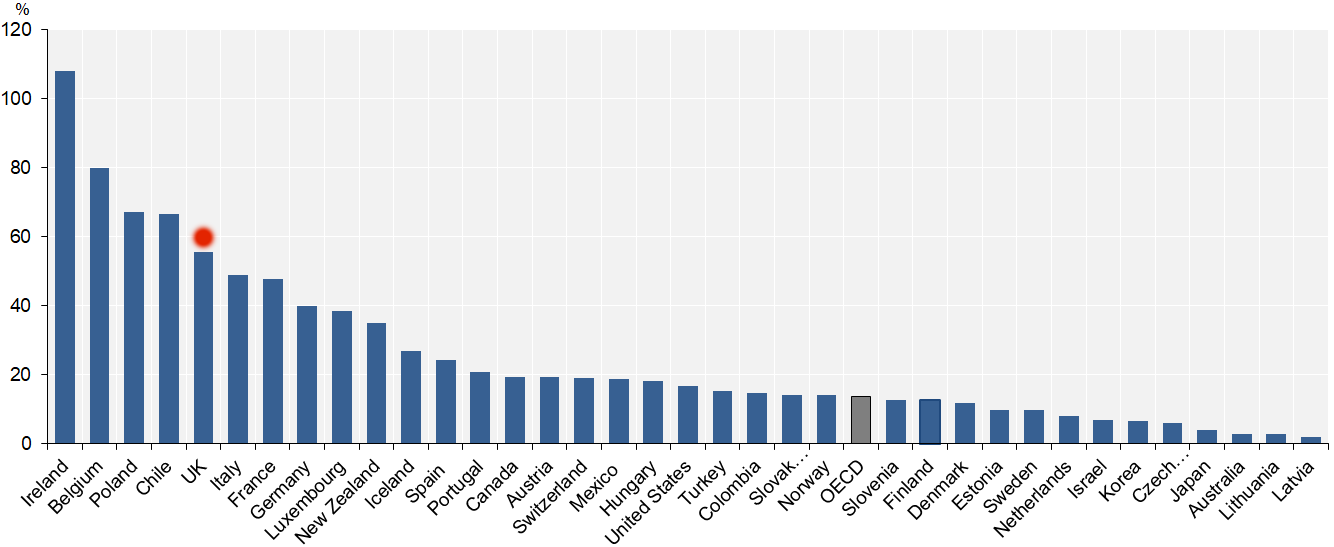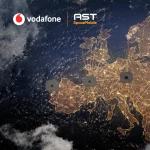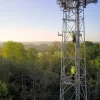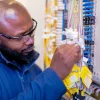Full Fibre Penetration Places UK Bottom of OECD Countries

The Organisation for Economic Co-operation and Development has found that 9 OECD countries out of 37 in total now have high-speed “full fibre” (FTTP) broadband making up 50% or more of their fixed internet connections, although sadly the UK is near the bottom of this table. But we’re growing fast.
At this point we should say that the OECD’s figures, which are said to have been collected in June 2019, appear to show full fibre “connections” (take-up) rather than network coverage. For example, the OECD reports that 2.33% of fixed broadband connections in the United Kingdom were for full fibre services, but we know from Ofcom’s data that coverage was at 8% in May 2019.
Nevertheless this doesn’t change the fact that the UK is still playing a distant game of catch-up with many other countries, which is something that plenty of other international comparisons have also shown (example). By contrast the top OECD country of South Korean scored 81.65% for full fibre connections, which is no surprise as they’ve been deploying FTTH for quite a long time.
Advertisement
Overall, in the year to June 30th 2019, the number of fibre subscriptions increased by 13.8% across the 37 countries measured (the 36 OECD countries plus Colombia). Meanwhile Cable networks (e.g. Virgin Media) remained stable with a slight increase of 4.3% in the year and accounts for a significant 33.6% of all fixed broadband connections. Elsewhere DSL (ADSL etc.) is rapidly being replaced by fibre and its share has fallen from 41.6% to 35.1% in two years.
Percentage of fibre connections in total fixed broadband, June 2019
| Country | 2019 Q2 | 2017 Q2 | 2015 Q2 |
| Korea | 81.65 | 76.0 | 69.7 |
| Japan | 79.03 | 76.2 | 72.7 |
| Lithuania | 74.61 | 69.1 | 60.8 |
| Sweden | 68.95 | 58.0 | 46.0 |
| Latvia | 68.54 | 62.3 | 59.7 |
| Spain | 62.53 | 40.0 | 16.9 |
| Iceland | 58.78 | 38.1 | 25.9 |
| Finland | 52.72 | 43.4 | 23.8 |
| Norway | 50.74 | 40.5 | 31.1 |
| New Zealand | 48.44 | 26.3 | 7.5 |
| Portugal | 48.18 | 35.4 | 24.1 |
| Luxembourg | 42.26 | 22.6 | 11.1 |
| Estonia | 40.14 | 35.2 | 33.3 |
| Slovenia | 38.41 | 30.5 | 23.6 |
| Denmark | 33.43 | 27.1 | 22.4 |
| Slovak Republic | 31.73 | 28.7 | 26.3 |
| OECD | 26.84 | 22.1 | 17.9 |
| Chile | 25.16 | 11.6 | 7.1 |
| Hungary | 24.91 | 19.6 | 15.5 |
| Mexico | 22.39 | 17.4 | 8.3 |
| Turkey | 21.53 | 18.8 | 17.2 |
| Poland | 19.99 | 9.3 | 4.9 |
| Switzerland | 19.93 | 13.4 | 9.5 |
| France | 19.78 | 9.5 | 4.4 |
| Czech Republic | 19.47 | 17.7 | 14.4 |
| Australia | 19.25 | 16.4 | 6.4 |
| Netherlands | 17.82 | 15.3 | 11.4 |
| United States | 15.55 | 12.1 | 9.7 |
| Canada | 15.09 | 10.6 | 5.3 |
| Colombia | 13.95 | 9.1 | 2.1 |
| Ireland | 8.76 | 1.4 | 0.3 |
| Italy | 6.04 | 3.1 | 2.4 |
| Germany | 3.58 | 2.1 | 1.3 |
| Austria | 2.68 | 1.8 | 1.5 |
| United Kingdom | 2.33 | 1.0 | 0.3 |
| Israel | 2.00 | 0.0 | 0.0 |
| Belgium | 0.98 | 0.3 | 0.2 |
| Greece | 0.16 | 0.2 | 0.2 |
The good news is that the UK is seeing rapid growth in full fibre take-up and indeed we’re one of the fastest growing countries in the OECD, sitting just below Ireland, Belgium, Poland and Chile on a score of 55.6% (see chart below).
Regular readers will know that there’s been a surge in FTTP deployments since 2017/18, which is thanks to various things like growing competition from alternative network ISPs (e.g. Cityfibre, Hyperoptic etc.), various Government supported investment funds / voucher schemes, relief from business rates on new fibre, a softening of regulation / rules and so forth.
Advertisement
Suffice to say that while the UK might be behind today, we’re catching up fast and appear to be on the right trajectory. The UK Government wants every home to have access to a “gigabit-capable” broadband connection by the end of 2025 (includes technologies other than FTTP) and, while we might not achieve that, it’s certainly possible that full fibre alone could cover around two thirds of premises by that date (currently over 12%).
Annual Growth of fibre subscriptions, June 2018-2019

Elsewhere Mobile Broadband (3G, 4G and 5G) subscriptions continue to grow strongly at a stable rate of around 7% a year. The countries with the highest penetration rates are Japan, Finland, Estonia, the United States and Australia, with subscriptions per 100 inhabitants at 177%, 155%, 153%, 150% and 144% respectively.
Advertisement
Mark is a professional technology writer, IT consultant and computer engineer from Dorset (England), he also founded ISPreview in 1999 and enjoys analysing the latest telecoms and broadband developments. Find me on X (Twitter), Mastodon, Facebook, BlueSky, Threads.net and Linkedin.
« Tesco Mobile UK Launches Ultrafast 5G Plans in 24 UK Cities
G.fast Broadband Gets Commercial UK Launch by Openreach »





















































Positive and negative.
Negative in that it shows a lack of full fibre, obviously.
Positive in that we have a bunch of alternatives that people are content with. They aren’t full fibre but they fulfill peoples’ needs for right now.
Everything is moving in a positive direction, though. So in the round we’re okay.
This shows how we need to catch up and fast and rethink the nation’s strategy on improving infrastructure and having a genuine private market of competition like in Japan. I sincerely hope people are not proud that the UK languishes near the bottom of the table. The regulator should be far more strict on marketing terminology and if necessary subsidies should be used to encourage and make the Fibre rollout as FAST and long term profitable (versus short termist and selective rollout) in the same way the Renewable/Wind farms were encourage by government and are now profitable without subsidy to make us one of the world’s best in that industry/energy generation.
@James Band
I would almost agree with you.
One disaster that was government created was the way the FiT tariffs were abruptly curtailed rather than ramped down. So that killed the development of domestic solar PV. OK the initial FiT was far too high but it could and should have just been reduced in line with reducing installation costs. OK now we would probably only pay FiT on units with battery storage so the grid was stabilised. Would save covering a lot of land with panels – there is plenty of roof in the UK. And there is a good energy efficiency case for local consumption as it reduces grid stress and transmission losses.
I not a big wind turbine fan but I do agree that the approach there has become valid.
Yes, there could/should be longer tax holidays for socially valuable investment such as FTTP to non viable areas.
Personally I think combined with topping up the voucher schemes decent tax holidays will probably get to around 90-92% FTTP.
As I have said a few times on here you cannot confuses the ‘non commercial final 20%’ with ‘non commercial final 10%’ or with ‘non commercial final 5%’ and I suspect even the final 2% also looks quite different.
This is a proper long tail problem where the costs for the most difficult properties are absolutely crazy.
Still getting to 90% would be a great move and I sense that this will happen with present will and resources. I be keen to steer thoughts away from too many rabbit hole technologies that don’t scale or stand the test of time and upgradabiltiy.
Am I the only one who thinks these numbers just represent pure embarrassment for the UK?
How are we expecting to encourage global business and talent to work here with this shambles? Why would anyone consider us a leading technical or engineering powerhouse with this horror story? Given the money that’s gone into the network over the past decades, how can anyone see this as anything other then completely pathetic.
I think it’s time for a BIG change regarding OpenReach and hopefully the government is waking up to this now. We need to clear the copper dinosaur out of the way and get some fresh competition in, time’s up.
OR have the largest number of FTTP passed. Fastest building.
Fastest compared to who? Certainly not the companies in the 34 countries ahead of the UK. Given their near monopoly status for years, state investment and line rental money, is this seriously a win? 2.33% (fact) – big round of applause everyone, oh no wait that’s a slow clap.
The annual growth figure suggests that fibre network build is now at a fairly healthy point, so I’m not sure what needs changing given that the option to travel back in time and start ten years earlier isn’t on the table.
the percentage growth on a tiny amount (even a large percentage) – is still a tiny amount. But I agree it’s a very encouraging stat to use for PR purposes.
WELL SAID.
We are languishing near the bottom of this table which is a national embarrassment. Other countries are clearly far ahead of us. Look at South Korea and Japan. And in Europe, Lithuania. It is a complete joke and acceptance of mediocrity to praise the FTTP rollout in the UK.
Instead of a measly rollout, ridiculously high prices (versus countries like Singapore, or continental Europe), overbuild in many areas, the British policymakers should be making it LAW that all copper lines are converted to Fibre period! That way it is COMPULSORY to upgrade the entire network and companies will find a way to make a profit. A subsidy scheme could have been launched similar to the way Wind farms are now fully profitable and we are a world leader in that sphere.
Openreach should be separated from BT otherwise there is a CLEAR conflict of interests.
It is no different to breaking up the monopoly of Standard Oil in the United States (today exists as multiple separate oil companies).
If you had one company (potentially with a national stake) called Royal Fibre, and had it managed like a Singaporean public entity, or a private network which was totally independent of an ISP, that was regulated with set targets to deliver FTTP and also speeds (e.g. 1000 by 2022, 10,000 by 2028), then it could tender out construction of the network in the same way the Olympic Stadium had contractors to build and GET THINGS DONE ON TIME.
ISPs can then pay a rental fee to Royal Fibre and ANY ISP can access the entire national network. Compare that to what we have now with barely any Fibre to the Premises, and multiple networks with no consistent national pricing for FTTP.
How are we in the >100M stats which may closer represent need.
Doesn’t surprise me, still poor fttp, even in built up area, OK conservation areas and objections to cabinets appearance and siting have slowed or stopped some roll-out, still lots of not spots for mobile, and only 2G still in some masts, hampered by nimbys stopping it too, a complete mess for someone wanting to run a business outside of the urban areas.
What matters to customers is the quality of the service they receive, and value for money. How it’s delivered doesn’t really matter. When 5G and LEO become available fixed line technologies could well become less relevant.
Meanwhile, my ISP has just upgraded my package to 108/8 Mbps, which is fast enough for me, over old-fashioned HFC.
Of-course the penetration will be low because Full Fibre is not UK traditional yet. Most people when they hear of FTTP think it is some sort of rocket science. Thus most wayleave agreements, planning permissions, etc are not happening smoothly in a timely manner, this is basically one of the biggest hampers of Full Fibre right now.
Think of ‘mind conditioning’ where FTTP must be accepted as a mainstream norm. Most people including government, private landowners, management teams have not had their brains conditioned yet to accept Full Fibre as a priority of importance. It is still being regarded as a luxury (nuisance). We need a shift in mindset.
I had to wait 10 years to finally get FTTC from an EO Line here in E1 London in October 2019.
Yes, I am lucky to finally get 80Mbps Download and 20Mbps Upload from my previous 12Mbps Download and 1Mbps Upload with ADSL.
5 years I have been trying to convince my management team to agree wayleave for Hyperoptic as we didn’t have FTTC and even Openreach had FTTP as plan and then it reverted back to FTTC.
So now I have to settle for FTTC instead which I am ok with for now at least I am getting 80000/19999 router sync speeds at around 300 meter cabinet. I agreed to sign up on a 24 month contract with TalkTalk for £21.95 because I know fully well that I am not going to get FTTP anytime soon in the next 2 years until UK legislation’s change to ease wayleave agreements.
If the regulator had a spine, then it would FINE Openreach, BT, etc for not hitting an ambitious timescale to upgrade all copper lines and upgrade people to FTTP by certain dates in each county of the country. If Ofcom would fine Openreach (and others) for not delivering FTTP in a 2 year build contract for each county, let’s say, £100 million, you would find FTTP being delivered by the summer of 2020.
@James Band: Without a shadow of a doubt! I believe there is no proper regulation or monitoring in this country, postcode by postcode, area by area. Why did I have to wait 10 years just to get FTTC here in Central near City of London and at the same time have a local management team blatantly refusing wayleave for Hyperoptic!
I was having a very unreliable ADSL service all these years where my noise margins had to be capped at 9dB to maintain stable sync just for 12Mbps otherwise my internet would constantly drop out on average 2-5 times in 24 hours.
If a communal TV aerial system is broken, you can probably sue your building management team. But if you don’t have decent broadband then your management team is not currently obliged to offer you such a service! This is a ridiculous law, as if having high speed broadband was any less important than having TV aerial signal working in full order.
I would’ve been delighted to see just wayleave agreements passed by summer 2020. But from observation just getting permission for installation takes a long process and after that for the installation to begin and complete takes another 1-2 years.
The truth is, however appreciative I may be for finally having FTTC right now with 80Mbps Download and 20Mbps Upload, I know this is just going to be here for another 5-10 years before getting FTTP from Openreach. Openreach will have this mentality that they upgraded my area with a new cabinet and will want this cost to be worth their investment.
Not to mention, having FTTC just gives a perfect excuse for private building management teams to deny wayleave agreements for FTTP as they will say “You’ve got FTTC, you don’t need FTTP!” This is another reason why FTTC has dragged down FTTP deployment in this country and why most countries in Europe have very high FTTP coverage because they began with FTTP directly from the very beginning!
I doubt whether fibre will cover much more than two thirds of premises as it just won’t be economic. For example in my estate I see that a significant minority of homeowners has opted not to subscribe to Virgin Media, and as VM will be able to offer Gig1 to everyone within a year it would make no sense for Openreach to overbuild with fibre.